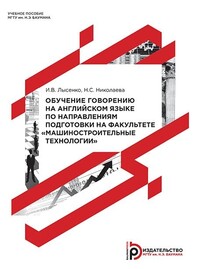Обучение говорению на английском языке по направлениям подготовки на факультете «Машиностроительные технологии»
Покупка
Тематика:
Английский язык
Год издания: 2016
Кол-во страниц: 44
Дополнительно
Вид издания:
Учебное пособие
Уровень образования:
ВО - Магистратура
ISBN: 978-5-7038-4397-0
Артикул: 840479.01.99
В издании впервые приводится базовый материал, направленный на обучение разным видам разговорной практики по тематике всех основных направлений подготовки на факультете «Машиностроительные технологии» (МТ). Пособие содержит текстовую информацию из оригинальной англоязычной научно-технической литературы, активную лексику, упражнения для отработки навыков монологической и диалогической речи по тематике специальностей и направлений подготовки, осуществляемых на факультете МТ, а также материал для подготовки презентации по специальности обучающегося. Для студентов старших курсов, магистрантов и аспирантов, обучающихся на факультете «Машиностроительные технологии» МГТУ им. Н.Э. Баумана.
Тематика:
ББК:
УДК:
ОКСО:
- ВО - Магистратура
- 15.04.01: Машиностроение
- 15.04.02: Технологические машины и оборудование
ГРНТИ:
Скопировать запись
Фрагмент текстового слоя документа размещен для индексирующих роботов
Московский государственный технический университет имени Н. Э. Баумана И. В. Лысенко, Н. С. Николаева Обучение говорению на английском языке по направлениям подготовки на факультете «Машиностроительные технологии» Учебное пособие
УДК 802
ББК 81.2 Англ-923
Л88
Издание доступно в электронном виде на портале ebooks.bmstu.ru
по адресу: http://www.ebooks.bmstu.ru/catalog/107/book1419.html
Факультет «Лингвистика»
Кафедра «Английский язык для машиностроительных специальностей»
Рекомендовано Редакционно-издательским советом
МГТУ им. Н.Э. Баумана в качестве учебного пособия
Лысенко, И. В.
Обучение говорению на английском языке по направлениям
подготовки на факультете «Машиностроительные технологии» :
учебное пособие / И. В. Лысенко, Н. С. Николаева. — Москва :
Издательство МГТУ им. Н. Э. Баумана, 2016. — 41, [3] с.
ISBN 978-5-7038-4397-0
В издании впервые приводится базовый материал, направленный на
обучение разным видам разговорной практики по тематике всех основных направлений подготовки на факультете «Машиностроительные технологии» (МТ). Пособие содержит текстовую информацию из оригинальной
англоязычной
научно-технической
литературы,
активную
лексику, упражнения для отработки навыков монологической и диалогической речи по тематике специальностей и направлений подготовки,
осуществляемых на факультете МТ, а также материал для подготовки
презентации по специальности обучающегося.
Для студентов старших курсов, магистрантов и аспирантов, обучающихся на факультете «Машиностроительные технологии» МГТУ
им. Н.Э. Баумана.
УДК 802
ББК 81.2 Анг-923
МГТУ им. Н.Э. Баумана, 2016
Оформление. Издательство
ISBN 978-5-7038-4397-0
МГТУ им. Н.Э. Баумана, 2016
Л88
ПРЕДИСЛОВИЕ Данное учебное пособие подготовлено для студентов старших курсов, магистрантов и аспирантов, обучающихся по направлениям подготовки и специальностям факультета «Машиностроительные технологии» (МТ) в техническом вузе. Издание содержит базовую информацию из оригинальных текстов англоязычной научнотехнической литературы для аудиторной и самостоятельной работы студентов при подготовке к экзаменам в VI–VII семестрах по тематике основных специальностей, приобретаемых на факультете МТ МГТУ им. Н.Э. Баумана. Принципиальная новизна учебного пособия заключается в том, что в нем приводится материал, направленный на обучение разным видам разговорной практики — профессионально-ориентированной монологической и диалогической речи студентов, магистрантов и аспирантов по основным специальностям факультета МТ. Пособие включает краткое введение и четыре блока. Первый, третий и четвертый блоки предназначены для обучающихся на всех специальностях факультета МТ. В первом блоке приведены некоторые ключевые фразы о том, где обучается студент, чтобы он смог представиться. В третьем блоке предложены вопросы на общетехнические темы, на которые студентам необходимо самостоятельно подготовить ответы. В четвертом блоке даны совет и ключевые фразы, полезные при подготовке презентации. Согласно числу направлений подготовки и специальностей факультета МТ, второй блок содержит 10 подразделов, в каждый из которых включены тексты по специальности обучающегося и упражнения. Эти материалы способствуют закреплению соответствующей терминологии, понятий и фактических данных, необходимых для развития монологической и диалогической речи по заданной теме.
INTRODUCTION Engineering is one of the oldest occupations in the history of mankind. It is the activity of applying scientific knowledge in such disciplines as physics and mathematics to the design, building and control of machines, roads, bridges, electrical equipment, etc. There are different kinds of engineering. They are: chemical, electrical, civil, mechanical, genetic, social, etc. Mechanical engineering separated as a specific field during the industrial revolution in Europe in the 18th century. And since then it has become the backbone of all areas of human’s activity as provides them with various types of equipment. Mechanical engineering is the discipline that applies the principles of physics, engineering and materials science fundamentals for the design, manufacturing, and maintenance of different mechanical systems in industry. This branch requires an understanding of core concepts of many theoretical sciences such as mechanics and kinematics, thermo- and aerodynamics, as well as computer-aided design, product lifecycle management, robotics and automation. Degrees in mechanical engineering are offered at various universities all over the world.
1. INTRODUCING YOURSELF I study at Bauman Moscow State Technical University or BMSTU for short. I’m a third (fourth) year student of the Faculty of Mechanical Engineering Technologies. My specialized department is … . (See the names in the table below). The department trains specialists in the field of ... . Specialized Departments Number of the Department Russian name English name МТ-1 Металлорежущие станки Machine Tools МТ-2 Инструментальная техника и технологии Tool Engineering МТ-3 Технологии машиностроения Industrial Processes МТ-4 Метрология и взаимозаменяемость Metrology and Interchangeability МТ-5 Литейные технологии Casting Technologies МТ-6 Технологии обработки металлов давлением Metal-forming Technologies МТ-7 Технологии сварки и диагностики Welding Technologies МТ-8 Материаловедение Materials Science МТ-10 Оборудование и технологии прокатки Rolling Technologies МТ-11 Электронные технологии в машиностроении Electronic Technologies МТ-12 Лазерные технологии в машиностроении Laser Technologies МТ-13 Технологии обработки материалов Material Processing Technologies


